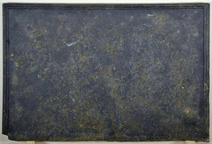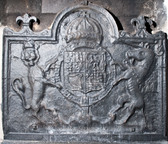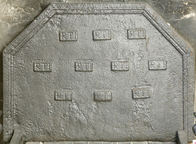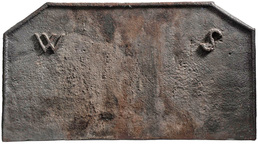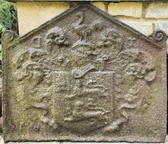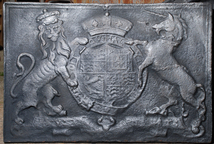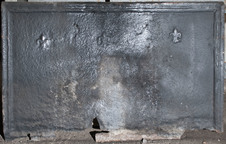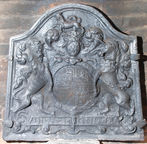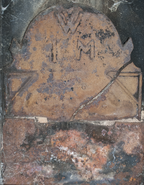-
1122
Description: Plain rectangular plate with cyma reversa, or ogee, moulding on top and sides.
Notes: A base board without other decoration. Other firebacks may have been cast using it.
- Decoration tags:
- rectangular (shape)
- cyma reversa/ogee (edging)
- carved pattern panels
Manufactured: in the 17th century in England.
Current location: 10 Garden Street, Accrington, Lancashire, England.
- Attached to series:
- Base boards
-
1208
Description: Arched rectangular shape with a fleur-de-lys springing from each shoulder; cyma recta-moulded edging; quartered shield of the Stuart royal arms of England with surrounding Garter, surmounted by a crown and supported by a crowned lion and unicorn; indistinct motto cartouche along the bottom.
Notes: A poorly-modelled and much-worn fireback. The fleur extensions to the top of the edging are an unusual feature
Arms: English Stuart royal
- Decoration tags:
- rectangular with round arch (shape)
- cyma recta (edging)
- whole carved pattern
- heraldic
- armorial
- royal
Manufactured: in the 17th century in England.
Current location: Blackwell House, Bowness-on-Windermere, Cumbria, England.
- Attached to series:
- Stuart royal armorial firebacks
-
876
Description: Canted rectangle; complex moulded edging (top and sides); rectangular incised initial stamp repeated ten times 3-4-3.
Notes: The use of an incised stamp is uncommon.
Inscription: RTI [repeated 10 times]
- Decoration tags:
- rectangular with canted top corners (shape)
- complex individual (edging)
- carved stamps
- text
Manufactured: in the 17th century in England.
Current location: Westwood Manor, Bradford-on-Avon, Wiltshire, England.
Museum number: 222509.1 (part of the National Trust museum group)
- Attached to series:
- Initials only firebacks
- Miscellaneous stamp firebacks
-
247
Description: A modified recasting of a variant of the ‘Armada’ fireback, with initials changed to IK, a single anchor panel, and the addition of a plain base and borders, the latter each with a twisted rope saltire, upper middle.
Notes: It is likely that an original four-panel fireback has been used to recast a copy with additional side and base panels; the saltires may have apotropaic significance. A second fireback at the house cast in the 19th century is identical but for being 1% smaller all round, and has a full-width extension on top bearing four symmetrical rope saltires, the outer two larger than the inner two. The first example was used to make the second.
Inscription: 1588 / IK
- Decoration tags:
- rectangular with round arch (shape)
- simulated rope (edging)
- simple stamps
- carved pattern panels
- composite
- extension panels
- apotropaic
- text
- plants
- objects
Manufactured: in the 17th century in the Weald area of England.
Current location: Chawton House, Chawton, Hampshire, England.
- Attached to series:
- Armada series
-
1124
Description: Canted rectangular shape; twisted rope edging (top and sides); initial in each top corner, the S angled to the right.
Notes: Initial letters are in high relief. The Pedestal Auction, Cirencester, 4 Mar 2019, lot 155 (£240).
Inscription: W S
- Decoration tags:
- rectangular with canted top corners (shape)
- rope (edging)
- carved stamps
- individual letters
- text
Manufactured: in the 17th century in England.
Current location: not known.
- Attached to series:
- Initials only firebacks
-
1302
Description: Triangular arched shape; double fillet edging with scrolls above the top corners; in front of mantling, a shield bearing two lions passant guardant with an indistinct canton; above it a helm and crest of a probable ostrich; initials, the D reversed, to left and right of upper mantling.
Notes: The arms have not been identified
Inscription: D T
Arms: Not known
- Decoration tags:
- triangular arched (shape)
- double fillet (edging)
- whole carved pattern
- individual letters
- heraldic
- armorial
- text
Manufactured: in the 17th century in England.
Current location: Francis Barber Architectural Salvage, Kelmscott, Gloucestershire, England.
- Attached to series:
- Personal armorial firebacks
- Loop edged firebacks
-
304
Description: Rectangular; cavetto-moulded edging; English royal Stuart shield, garter, crown, supporters and motto.
Notes: One of many designs of the Stuart royal arms on firebacks. A recasting, hence the illegible motto. Sold at Christie's Masters and Makers auction, 30 November 2010, lot 517 (£1,875).
Copies of this fireback are known.
Inscription: HONI SOIT QVI MAL Y PENSE / DIEV ET MON DROIT
Arms: English Stuart royal
- Decoration tags:
- rectangular (shape)
- cavetto (edging)
- whole carved pattern
- armorial
- royal
- text
Manufactured: in the 17th century in England.
Current location: Suffolk House Antiques, High Street, Yoxford, Suffolk, England.
- Attached to series:
- Stuart royal armorial firebacks
-
1283
Description: Rectangular shape; ogee-moulded edging; upper centred, small fleur-de-lys stamp impressed three times, the rightmost slightly higher than the other two.
Notes: A simple fireback of somewhat indeterminate date.
- Decoration tags:
- rectangular (shape)
- cyma reversa/ogee (edging)
- carved stamps
- heraldic
- objects
Manufactured: in the 17th century possibly in the Weald area of England.
Current location: Ripley Forge & Fireplaces, Northbridge Street, Robertsbridge, Salehurst, East Sussex, England.
- Attached to series:
- Miscellaneous stamp firebacks
-
666
Description: Inclined rectangle with ogee arch; fillet and ogee moulded edging; garter enclosing English Stuart royal arms, with supporters, helm, crest, mantling and motto.
Notes: Standard armorial design; the inclined shape is uncommon.
Inscription: [Garter motto illegible] DIEV ET MON DROIT
Arms: English Stuart royal
- Decoration tags:
- rectangular with round arch (shape)
- ovolo (edging)
- whole carved pattern
- armorial
- royal
- text
Manufactured: in the 17th century in England.
Current location: in private hands, Rolvenden, Kent, England.
- Attached to series:
- Stuart royal armorial firebacks
-
1200
Description: Arched rectangular plain shape with the sides of the arch concave, and with a diamond-shaped protrusion on each side; astragal edged sides terminating at the shoulders of the platre with a triangle on each side; top centre, initials in triad.
Notes: As small and unusual fireback of which only the upper part is visible, the lower part concealed behind a metal plate.
Inscription: IWM [triad]
- Decoration tags:
- rectangular with round arch (shape)
- astragal (edging)
- individual letters
- text
Manufactured: in the 17th century possibly in the Weald area of England.
Current location: in private hands, Scaynes Hill, West Sussex, England.
- Attached to series:
- Initials only firebacks
